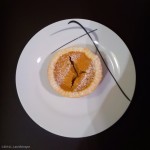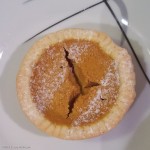Today on Food on Fridays I want to talk about pumpkin, a food that factors into a traditional autumn dessert in North America, but not here in Germany.
I mean, in North America in the fall, pumpkins are everywhere: in decorations for Halloween, in vegetable counters in grocery stores, and in cans to make into pumpkin pie.
OK, that last part is a little bit of a joke, as one can of course make pumpkin pie starting with a whole pumpkin. At least, I assume one can do that. Growing up I knew that fresh apples were necessary to make an apple pie from scratch, but for whatever reason, canned pumpkin — never fresh pumpkin — was used to make a pumpkin pie. Even when fresh pumpkins were in season and used for jack-o-lanterns at Halloween. So, I grew up thinking that it was necessary to buy a can of Libby’s-brand pumpkin to make a pumpkin pie.
Now, my New England-raised husband and his brothers informed me that in fact you don’t use Libby’s pumpkin for pumpkin pie: rather, for them, the one true pumpkin pie is made from One-Pie canned pumpkin.
Clearly, the canned pumpkin you grew up with is the one you make the one true pumpkin pie with, I guess. 😉
But whatever the brand of canned pumpkin — or fresh pumpkin — you make it with, pumpkin pies are traditionally found in autumn all over North America.
Here in Germany, though, pumpkins don’t seem to be made into desserts. Other fruits and vegetables, yes (e.g. apples, cherries, raspberries, rhubarb). They sell all kinds of pumpkins and other round varieties of squash in both the grocery stores and farmer’s markets, but I guess no one ever thought to make a dessert filling with it here. Or it least it never caught on.
So it was unusual to see a mini pumpkin cake being sold by a local bakery at the recent autumn festival here in Tübingen. This was the first and only time in the 3 years we’ve lived here that I’ve seen anything like it. In the name of research, we of course had to try one.
- Mini pumpkin cake on small plate to show size
- Mini-Pumpkin Cake, Tübingen
It was tasty, but not quite like pumpkin pie, since it was really more of a cake than a pie. It wasn’t as sweet or as creamy as North American pumpkin pies tend to be.
But then again, it was probably made from fresh pumpkin, not with the canned stuff. So, it couldn’t ever really hope to match my memory of a true pumpkin pie taste, now could it. 😉
*****
Earlier this week Chris and I happened to stumble onto some old episodes of the George Burns and Gracie Allen TV show from the 1950s. That show turned out to be sponsored by Carnation Evaporated Milk, with a tagline that the milk came from “contented cows”. I’d heard that somewhere before, I think, but I’m not sure where, as I didn’t really ever use Carnation Evaporated Milk to cook with.
Except, of course, to make pumpkin pies; the recipe on the back of that Libby’s can called for Carnation Evaporated milk. And sure enough, in the 3rd episode, somebody uses Carnation Evaporated Milk to make a pumpkin pie. Unfortunately, she makes it off-screen, so I don’t know what type of pumpkin she used…
Anyway, I thought it was funny that we happened to see this episode just as I was plotting my pumpkin pie post for today. Sometimes things just all fall together in the oddest ways for my posts.
Below are a few links to a couple of the Burns and Allen episodes we’ve watched. I though Gracie Allen was hysterical in Episode 1, so I’ve included that along with a link to Episode 3, which mentions the pumpkin pie.
I’ve also included Episode 2, since that comes the closest to giving me a Broadway showtune to throw in today, too. The musical performance number is by a the up-and-coming dance duo: Fosse and Niles. As in, the great stage and screen choreographer and director Bob Fosse and his first wife, Mary Ann Niles. Fun to check out a young Bob Fosse in action.
Enjoy.
Burns and Allen TV episodes:
- Episode 1: my favorite of the ones we’ve watched so far
- Episode 2: Fosse and Niles starts around 9:20
- Episode 3: a pumpkin pie factors into the second half of the episode, sort of



Thanks for the note about contented cows, one of advertising’s great creations!
But the real revelation in your post was the lack of pumpkin pie in Germany. This got me thinking. The pumpkin is native to the Americas–same for squash, from Narragansett asquutasquash, close to Chris’s birthplace. Thus, it was tempting to guess that the pie originated with native Americans and then was linked to Thanksgiving.
But no! Indians and early settlers here used pumpkins much as you describe for today’s Germans. But after the pumpkin was exported to Europe, it was the *British* who brilliantly made it into pie. It was then re-imported to the U.S.
Did we at least develop the technology for canning that makes Libby’s (and One-Pie, for anyone who has heard of it) possible? No it was the French, who devised it to feed their troops in the Napoleonic wars.
So today’s pumpkin pie is truly the fruit of international collaboration.
Thanks, Will. Yes, the “contented cows” was a great advertising campaign that goes way back. And thanks also for doing such an extensive investigation in to the history of pumpkin pie. I had no idea it was British; I think I probably did assume the Indians had taught it to the Pilgrims, or something like that, and so investigated no further. Nice to see that pumpkin pie is so officially international … now we just need to figure out how to make it more widespread here in Europe…
Please forgive me if this is more than anyone cares to know about pumpkin and pie, but with Thanksgiving coming up, this passage from the Oxford Encyclopedia of Food and Drink in America makes the colonial situation clearer:
“Pumpkins … became a common food at all meals, particularly in New England. They were baked, fried, mashed, roasted, and stewed, and eaten as an accompaniment to meat….Pumpkins were … used to make puddings, pancakes, pies, soups, stews, and tarts. Less commonly, pumpkins were used as a flavoring in bread, cakes, and muffins and were also employed to make ale.”
This is the source for my point that the British developed pumpkin pie, and indeed the source goes on to say that “Culinary fakelore to the contrary, pumpkin pies were not served at the proverbial “First Thanksgiving” and did not become common as a dessert at Thanksgiving dinner until the early nineteenth century.”
You know they’re serious when they make up the Palinesque term “fakelore.” But they’ve already said that in colonial New England pumpkin was used for “tarts.” And the Oxford entry for “pies and tarts” says that “Tarts are essentially open-face pies.” Well, duh! Pumpkin pie, being open-faced, qualifies for tarthood, and so nothing here really challenges your assumption that pumpkin pie (albeit as tarts) was served at the first Thanksgiving dinner.
However, the following article seems to dash this assumption, since there was no wheat flour or butter: http://www.smithsonianmag.com/ist/?next=/history/what-was-on-the-menu-at-the-first-thanksgiving-511554/
I’ll stop without proceeding to squash, since we know that squash pie would have been equally impossible without flour and butter. Still, the thought lingers that the Pilgirms and Indians theoretically could have dined on a gluten-free tart whose crust was made of ground acorn meat and shortening or lard.
Wow, thanks, Will! I’m sure that when I learned about the first Thanksgiving in elementary school, a teacher’s random “they had a meal just like ours” type of comment made me think they had pumpkin pie. It is funny that here in Tübingen (and the Schwabian area in general), a pumpkin soup is quite popular, but nothing sweet.
In Bolzano the first year they had the whole Zucca festival with all types of squash, and all types of foods made from it. My favorite way to eat it there was in a thin ravioli-like pasta with pumpkin/squash filling ( (I think info about it is also in my book). http://22bz.wordpress.com/2008/10/12/zucca-festival-the-food/
Anyway, I love all the extra research you’re doing – keep it coming!
@Will: One more thing: hopefully you know why Turkey was served on Thanksgiving, right? I mean, I know what Smithsonian says, but the real story (according to Stan Freberg) can be found on this website: http://baltimorejam.wordpress.com/2010/11/24/thanksgiving-tradition-according-to-freberg/
Wow, thanks for setting me straight, Linda! But, as with your revelations about the deceptive marketing of eau de cologne and the involvement of the clergy,we’d better keep this “entre nous.”
Freberg has not been heard from in a while, but he’s 88 and his most recent marriage was in 2001, so he seems to be holding up well.